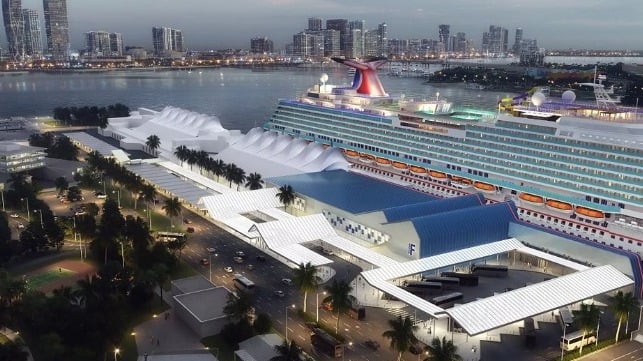PortMiami Receives Federal Money for Pilot Shore Power Program

PortMiami is proceeding with a pilot program to develop shore power to permit cruise ships in the port to begin cold ironing. The port is receiving a $2 million allocation from the U.S. Environmental Protection Agency’s Diesel Emissions Reduction Act to help fund the Shore Power Pilot Program.
In the first phase of the pilot program, PortMiami and Carnival Cruise Line will be working together along with Florida Power and Light to bring shore power to the new Cruise Terminal F under construction at the port. Pending the completion of the pilot program study and the necessary infrastructure work, Carnival Cruise Line will commit to utilizing shore power for up to four vessels at new Cruise Terminal F, starting in 2023.
In February, Miami-Dade County signed a joint statement with six of the cruise companies operating from the port, including Carnival Corporation, Disney Cruise Line, MSC Cruises, Norwegian Cruise Line, Royal Caribbean Group, and Virgin Voyages, and Florida Power and Light to introduce shore power capabilities to PortMiami.
“We’re so proud that efforts to bring shore power to PortMiami are quickly progressing,” said Mayor Daniella Levine Cava. “This DERA grant will help us fund shore power infrastructure making PortMiami the first seaport in Florida and the southeastern United States to provide this connection. We are committed not just to bringing back cruising in the months ahead – but to building back a more resilient cruise industry and continuing to make the Port a leader in sustainability."
PortMiami had been criticized for not moving sooner to incorporate shore power capabilities into the current expansion and modernization efforts underway for the cruise terminals. Both Royal Caribbean Group and Norwegian Cruise Line Holdings recently completed the construction of new terminals that did not include shore power. Work is also underway to build a new terminal for Virgin Voyages, along with plans for a new terminal for MSC Cruises and Disney Cruise Line to be built at the eastern end of Dodge Island.
PortMiami in January 2021 celebrated the groundbreaking for the expansion project which is renovating an existing cruise terminal into a modernized 471,000-square-foot facility known as Terminal F. It will be Carnival’s third terminal at the port and its largest in South Florida. Under the pilot program, it will also become the first with shore power capabilities.
“We appreciate Mayor Levine Cava’s leadership to move this pilot project expeditiously through the process. Carnival welcomes this development and the opportunity to serve as the partner in the shore power pilot program at PortMiami,” said Christine Duffy, president of Carnival Cruise Line. “In combination with our Terminal F project and the Carnival Celebration LNG ship we are bringing to Miami in 2022, the DERA grant provides additional momentum to the shared goal of enhanced environmental operations.”
PortMiami is catching up with other ports in North America and Europe that have introduced shore power. The Port of San Diego recently announced it will invest $4.6 million to double shore power capability to allow two cruise vessels calling on San Diego to connect to shore power outlets at the same time. San Diego first introduced shore power able to handle one cruise in 2010. The port’s goal is to complete the shore power expansion by September 2022, four months ahead of recently updated California Air Resources Board (CARB) regulations that require essentially all cruise ships calling at California ports to use shore power beginning January 1, 2023.
European ports are also working to expand their shore power capabilities in advance of similar regulations from the EU that will require most commercial ships to begin using shore power to lower emissions and improve the environment around the ports.
